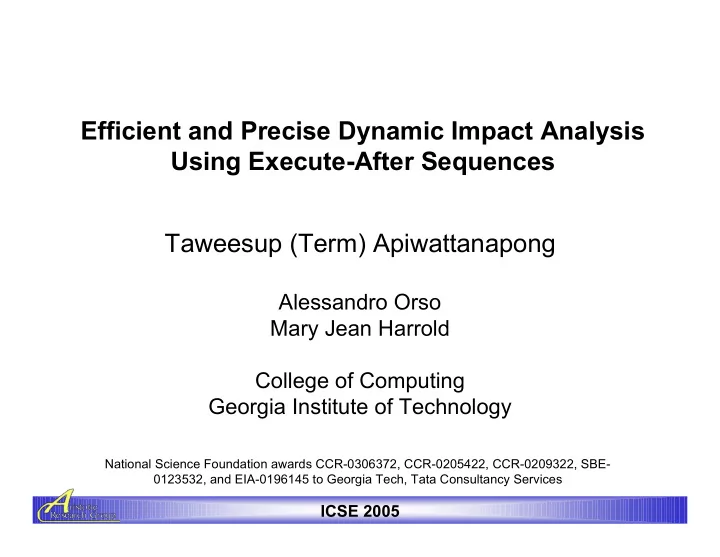

Efficient and Precise Dynamic Impact Analysis Using Execute-After Sequences Taweesup (Term) Apiwattanapong Alessandro Orso Mary Jean Harrold College of Computing Georgia Institute of Technology National Science Foundation awards CCR-0306372, CCR-0205422, CCR-0209322, SBE- 0123532, and EIA-0196145 to Georgia Tech, Tata Consultancy Services ICSE 2005
Development and Maintenance Impact analysis results Develop Develop T Augment T P for P for untested parts of P Modify Select subset P correct T P of T to rerun for T? F F Identify T adequate? faults T Release P
Outline • Dynamic Impact Analysis • Existing Techniques • Our Technique • Empirical Studies • Related Work • Conclusion
Impact Analysis Change = {C} A Static Impact Analysis M Impact Set = {M, A, B, C, D} B C D calls returns Dynamic Impact Analysis Impact Set = {M, A, B, C}
Dynamic Impact Analysis Impact-analysis techniques that • Are based on dynamic information (e.g., test suites, field executions) • Are conservative w.r.t. dynamic information Quality of the dynamic information is key! • representativeness of actual usage collect actual usage efficiency is important Two existing dynamic impact-analysis techniques • PathImpact • CoverageImpact
Existing Techniques Change = {C} A PathImpact M B M A r … A r B C r r B x C D Impact Set = {M, B, C} CoverageImpact M A B C D 1 1 1 1 0 Impact Set = {M, A, B, C}
Execute-After (EA) Relation Essential information is Z N Y M X “Execute-After Relation” Definition Given a program P , a set of executions E , and two methods X and Y in P , ( X , Y ) ∈ EA for E if and only if, in at least one execution in E , 1. Y calls X (directly or transitively (d/t)), 2. Y returns into X (d/t), or 3. Y returns into a method Z (d/t), and Z later calls X (d/t).
Computing EA Relation Use method-entry and A method-return-into events M M e A e M i … A e M i B e C e B i M i B e B C Use only the first and last D events of each method M e A e A e B e C e M i B e Execute-After (EA) Sequence M f A f A l B f C f C l M l B l
Our Technique F L A 2 2 M 1 1 B C D Current Timestamp: 3
Our Technique F L A 2 8 M 1 9 B C D Current Timestamp: 10
Our Technique F L A 2 8 M 1 13 B 10 14 C 11 11 D Current Timestamp: 15 Sort the entries to obtain an Execute-After (EA) Sequence M f A f A l B f C f C l M l B l
Analytical Complexity Techniques Space Time (per method call) PathImpact O (t) O (t) CoverageImpact m bits O (1) Execute-After 2m integers O (1) Program size: 30 KLOC Trace size: 2 GB t = the size of the trace m = the number of methods
Outline • Dynamic Impact Analysis • Existing Techniques • Our Technique • Empirical Studies • Related Work • Conclusion
Empirical Studies Studies – Efficiency – Precision Experimental Setup Tool: EAT (Execute-After Tool) Subject Programs: Program Versions Classes Methods LOC Test Cases Siena 8 24 219 3674 564 Jaba 11 355 2695 33183 125 Jaba-long 11 355 2695 33183 90
EAT (Execute-After Tool) instrument execute analyze Instrumented EA sequence Program Impact Set (arrays F and L) Program Instrumentation module Analysis module Runtime monitors EAT Collecting method-return-into events Normal return Exceptional return into a catch block Exceptional return into a finally block
Study 1: Efficiency Goal: To evaluate relative execution costs for Execute-After (EA) wrt CoverageImpact (CI) and PathImpact (PI) Method: Measure time to execute programs on test cases, gather dynamic data, and output information to disk. Running time (ms) Overhead (%) Program Uninst. CI EA PI CI EA PI Siena 53 108 110 ~263 104 108 ~396 Jaba 432 463 486 ~54,000 7.18 12.50 ~12,400 Jaba-long 5257 5617 5861 - 6.85 11.49 -
Study 2: Precision 60 Goal: To compare the CoverageImpact PathImpact precision of the three Execute-After 50 techniques 50% smaller (250 methods) 40 Method: Measure the relative sizes of 30 impact sets computed by the techniques. 20 10 0 v0 v1 v2 v3 v4 v5 v6 v0 v1 v2 v3 v4 v5 v6 v7 v8 v9 v0 v1 v2 v3 v4 v5 v6 v7 v8 v9 Siena Jaba Jaba-long
Related Work PathImpact (Law and Rothermel) based on lightweight dynamic forward slicing CoverageImpact (Orso et al.) based on compressed program traces Online impact analysis (Breech et al.) compute impact sets online space complexity: x 2 time complexity (per method call): O (x) ( x is the number of methods executed)
Conclusion Summary • identify essential information for dynamic impact analysis • present a new, efficient, and precise technique to collect and analyze that information • present a set of empirical studies which show the efficiency and effectiveness of our technique Future directions • perform studies using the technique in the field • perform client-analysis • generalization of the technique – levels of granularity – programming languages • apply the technique to other dynamic analyses – reverse-engineering – recovery of feature interaction
Thank you. Questions?
Recommend
More recommend